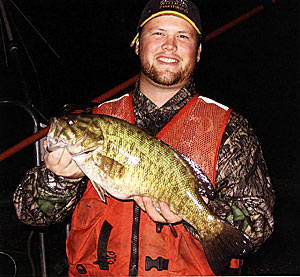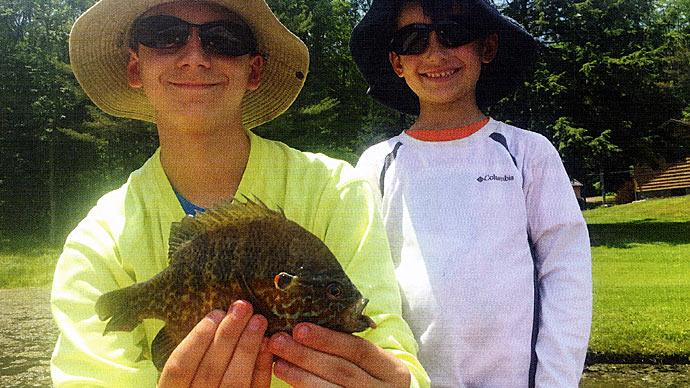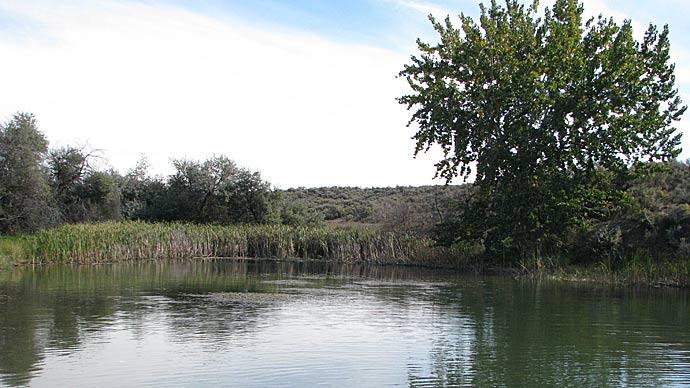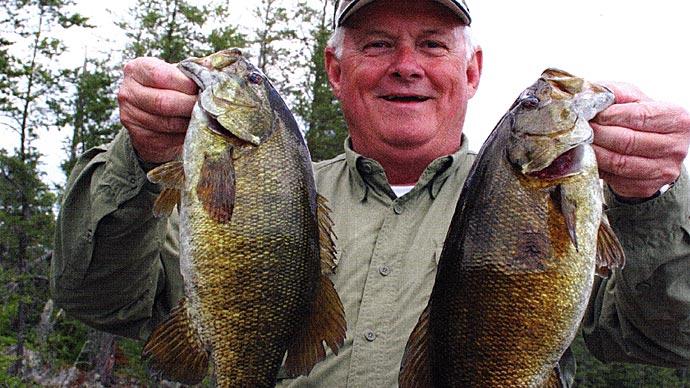
A sunfish that can reach several pounds and won't overpopulate? Wow! What can be sweeter music for a pondmeister's ears?
There is indeed such a fish—the redear sunfish. Also known as shellcracker or chinquapin perch, stumpknocker, or yellow bream, their scientific name is Lepomis microlophus. Lepomis is the Greek word for "scaled gill cover," while microlophus is the Greek word for "small nape." Redears are cousins to the bluegill, green sunfish, and pumpkinseed.
Redear sunfish are known to grow faster and achieve larger sizes than bluegill found in the same waters (Pflieger 1997). The current world record was a 5 lb, 7 oz fish caught in the Santee-Cooper Diversion Canal in South Carolina during August of 1998! Can you imagine that? State records in the south often exceed 4 lbs, while as you move farther north, the record decreases. For example, the Kansas state record redear is 1 lb, 8 oz.
Redear sunfish are native from Missouri and Indiana, down to North Carolina and Florida and then west to eastern Texas. They have been introduced in Oklahoma, Kansas, Iowa, Nebraska and we even have a population in southwestern South Dakota. While they are considered a "southern" fish, there is a very thorough report on redear sunfish in Michigan that is available on the Web.
We listed that web link back in the Reference section for this paper (Towns 2003).
The redear sunfish is a deep sunfish with a small mouth. They have a long pectoral fin which will reach past the front of their eye when bent forward. Rakers on the front of their first gill arch are short and stout (this separates them from the bluegill, which has long rakers). They have a reddish or orange tab on the posterior edge of their ear flap. The pumpkinseed also has a red or orange tab, but pumpkinseeds have wavy blue lines near the mouth and dark spots on their soft dorsal fin that redear sunfish do not have.
Redear sunfish primarily feed on the bottom and seldom feed on surface insects, especially compared to bluegill. Like many fishes, newly hatched redear sunfish feed on zooplankton. Also, like many fishes, adults will feed on a variety of food organisms, depending on what is abundant and what is vulnerable.
Common food items are midge larvae, snails, mayfly larvae and dragonfly/damselfly larvae. Redear sunfish have "molariform pharyngeal teeth," which are grinding surfaces in the throat (think of the molars in your mouth). Thus, they can grind snails and small clams because of these structures. Bluegills do not have such structures and thus cannot grind. Pumpkinseeds do have the grinding pharyngeal teeth and are the snail eating sunfish of the north. Both redear sunfish and pumpkinseeds have that further benefit in their ability to eat snails, which often are hosts for fish parasites. Common examples are yellow grub and black-spot disease. If the snail population in a pond is reduced, the parasite cycle is disturbed and the incidence of the grubs may decline.
Now let's turn to the idea of limited reproduction by redear sunfish. That is the primary difference between redears and the other sunfishes. Nearly all sunfishes have the tendency to overpopulate due to high reproductive rates which can lead to high abundance and small sizes for adult sunfish. Bluegills and pumpkinseeds, for example, are well-known for overpopulating.
Dr. Homer Swingle was the first to notice the low reproductive capacity for redear sunfish. In fact, he suggested that a largemouth bass-redear sunfish combination was not effective for Alabama pond management because of the low reproduction by redears (Swingle 1949). He. suggested that a "buffer" species such as bluegill should also be used with largemouths and redears. The higher reproductive capacity of the bluegill was needed to provide sufficient prey for the largemouth bass.
Redear sunfish are often considered to be single spawners, but that actually is not correct. Both Dr. Bill Pflieger of Missouri and Dr. Swingle in Alabama found redears that were spawning into late summer or early fall. So, the low reproductive capability is just something that is built-in (intrinsic) for the redears.
Now, let's turn back to the largemouth bass-redear sunfish combination. Don Gabelhouse is currently the fisheries chief with the Nebraska Game and Parks Commission. He did his master's degree work at the University of Missouri under the guidance of Dr. Richard Anderson. Yes, the same Dick Anderson who helped us kick off the first Pond Boss Conference and Expo in Dallas/Fort Worth in 2007!
Don's graduate research involved largemouth bass and redear sunfish (Gabelhouse 1978). He sampled four small Missouri ponds that ranged from only 0.1 to 0.4 acres. The largemouth bass averaged 58 pounds per acre (range of 27 to 118), while the redear sunfish averaged 298 pounds per acre (range was 232 to 356). One pond had just a few bluegills and another pond had some green sunfish, but redears made up most of the sunfish biomass. Don also found that the redear sunfish had highly variable year-class strength, but so did the largemouth bass.
So, how might a pondmeister take advantage of the low reproductive capability of redear sunfish? Well, for one thing, we might pair them up with a less effective predator. Believe it or not, the smallmouth bass simply is not as efficient a predator on small fishes as is the largemouth bass. For example, we do not recommend the use of a smallmouth bass-bluegill combination for a 3-acre hill pond that has 30% submergent vegetation coverage during midsummer. Such a scenario creates a large risk for a stunted bluegill population and loss of reproduction by the smallmouth bass. However, because of the lower reproductive capacity of the redear sunfish, they do make a good combination with smallmouth bass.
When Don Gabelhouse was still working with the Kansas natural resource agency, he did utilize the smallmouth bass-redear sunfish combination for pond management. However, one primary note of caution. Don't let largemouth bass get into the pond. They will eventually take over, and smallmouths will gradually disappear from the pond. In small waters, the smallmouths just can't hold their own as they do in large reservoirs or large natural lakes.
Many pond owners have recently discovered the joys of having smallmouth bass in their ponds. Smallies are incredible fighters and much fun in a pond. By pairing them with redear sunfish, you get the fun of the smallies, and still have the opportunity to harvest a large panfish. Given the ability of smallmouth bass to utilize a wide variety of prey organisms, including insects, crayfish, and fishes, they likely will not over-consume the small redears.
We visited with Dr. Jeff Slipke of Southeastern Pond Management, Inc., to see if he had been using the smallmouth bass-redear sunfish combination. He indicated that he had not, although he would like to do more of such work. Apparently, this combination has not been much discussed for southern ponds, although he's hearing a lot more interest in smallmouth bass these days.
So, can you have a terrific smallmouth bass population and the capability to catch panfish large enough for the frying pan? We think so. Perhaps we'll hear more results from this smallmouth-redear combination in the coming years. Hmmm, sounds like a good graduate student research project, doesn't it?
References
Gabelhouse, D.W., Jr. 1978. Redear sunfish for small impoundments. Pages 109-123 in G.D. Novinger and J.G. Dillard, editors. New approaches to the management of small impoundments. North Central Division, American Fisheries Society, Special Publication Number 5, Bethesda, Maryland.
Pflieger, W.L. 1997. The fishes of Missouri. Missouri Department of Conservation, Jefferson City, MO 65102.
Swingle, H.S. 1949. Some recent developments in pond management. Transactions of the North American Wildlife Conference 14:295312.
Towns, G.L. 2003. Redear sunfish management in Michigan. Michigan Department of Natural Resources, Fisheries Technical Report 2003-03, Lansing. (http://www.michigandnr. com/PUBLICATIONS/PDFS/ifr/ifrlibra/tech nical/reports/2003-3tr.pdf).
Justin VanDeHey is a Ph.D. student and Dave Willis is the Department Head in Wildlife and Fisheries Sciences at South Dakota State University. Justin is a past recipient of the Jesse W. West Research Endowment sponsored by the Pond Boss family.
Reprinted with permission from Pond Boss Magazine



